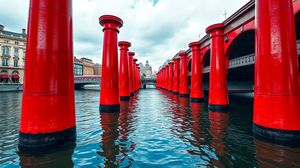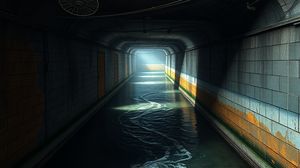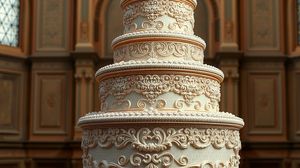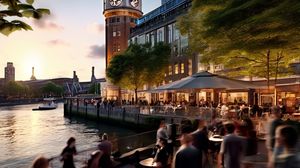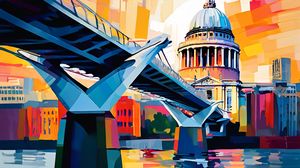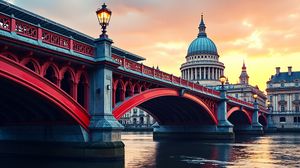
Blackfriars Bridge is a historic and iconic structure bridging the River Thames in London, connecting the City of London on the north bank with the South Bank. Its significance dates back to the mid-19th century when it was first opened in 1869. The bridge you see today, however, is a replacement of the original, completed in 1869 and redesigned in 1971 to accommodate increasing traffic and modern engineering standards.
One of the most fascinating aspects of Blackfriars Bridge is its dual function, serving both vehicular traffic on its upper deck and trains below through the adjacent Blackfriars Railway Bridge. This makes it unique among London's bridges, with commuters speeding across its span throughout the day.
Architecturally, Blackfriars Bridge stands out with its Victorian-era wrought iron detailing. The southern end of the bridge features four massive stone piers that hint at the grandeur of an earlier age. These piers supported the original railway bridge and now serve as a reminder of the area's rich industrial history.
A striking feature to look out for is the famous bridge lanterns. These ornate details depict graffiti art in an elegant, historical style, offering a modern twist on traditional Victorian illumination. They give the bridge an artistic flair, which is often overlooked amidst the hustle and bustle.
Blackfriars Bridge has captured the imagination of several famous artists and writers over the years. Notably, it appears in Charles Dickens' novels, underscoring its cultural significance during the Victorian era and its lasting impact on British literature.
The bridge provides one of the most stunning views of the Thames, especially during sunset. On clear days, you can enjoy breathtaking panoramas reaching from Westminster to St. Paul's Cathedral in the north and the enchanting London Eye to the south, making it an exceptionally picturesque location.
As you walk across the bridge, you'll notice a plethora of statues of famous Blackfriars. These statues serve as a nod to the Dominican friars who lent their name to both the bridge and the surrounding area. This historical context enriches the experience of traversing this illustrious structure.

Making the Most of Your Visit:
Start your visit by walking across the bridge from the south side. As you do, pause for a moment to take in the stunning view of St. Paul's Cathedral framed perfectly at the north end. It's one of those picture-perfect moments you don't want to miss.
If you're there in the late afternoon, make sure to catch the sunset. The way the sunlight reflects off the river and the city skyline transforms the scene into a beautiful, almost magical spectacle.
While you're on the bridge, take a closer look at the ornate Victorian lanterns. They're easy to overlook, but these detailed pieces of art offer a glimpse into the historical richness of the area and the design intricacies of the time.
Don't just stick to the central part of the bridge. Head to the west side of the span and you might spot some of London's iconic landmarks like the London Eye. It's a different perspective and one that can offer great photo opportunities.
If you're interested in architecture and history, take some time to admire the bridge's support pillars at low tide. They are remnants of the past and tell stories of the bridge's original design and structure.

Visiting Times & Costs:
Blackfriars Bridge is open to the public 24 hours a day, every day of the year. There is no cost to cross the bridge as it is a public thoroughfare.
The bridge is accessible for pedestrians, cyclists, and vehicles. It has footpaths on both sides to accommodate walkers and offers ramps for easier access for those with mobility issues or using wheelchairs. However, as it is a busy traffic route, care should be taken while crossing the road sections of the bridge.
Users should be aware that, given its open-air setting, accessibility could be affected by weather conditions, such as rain or icy surfaces in winter.

Address & Map:

Nearby:
